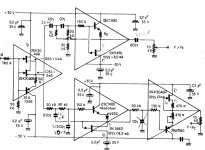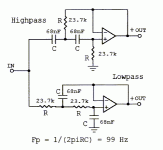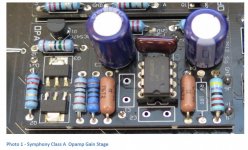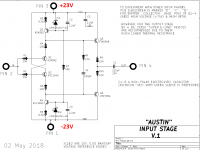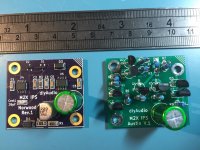There are some active filters based on voltage followers, such as Linkwitz-Riley crossover, etc. Usually those voltage followers are described as operational amplifiers connected as voltage followers. But there are many ways to make a voltage follower, and an operational amplifier is just one of the possibilities.
I was thinking that searching for an ultimate voltage follower for an active audio filter would be reasonable, but very soon after I realized that someone may have found it already.
Opinions?
I was thinking that searching for an ultimate voltage follower for an active audio filter would be reasonable, but very soon after I realized that someone may have found it already.
Opinions?
"Ultimate" is a rather extreme word; one might even call it unreasonable. How would you know if you found it?
Best sounding or best measuring? If the latter, go for opamps.
Opamp implementations don't tend to sound as good as discretes but in the main the deficiencies can be corrected by running balanced with classA bias (a CCS) on the opamp's output and a sufficiently low supply impedance. I'm currently getting very good sounding results from AD8065s in my active filters - though I'd recommend using MFB rather than Sallen-Key if you choose to use an opamp as the active element.
Opamp implementations don't tend to sound as good as discretes but in the main the deficiencies can be corrected by running balanced with classA bias (a CCS) on the opamp's output and a sufficiently low supply impedance. I'm currently getting very good sounding results from AD8065s in my active filters - though I'd recommend using MFB rather than Sallen-Key if you choose to use an opamp as the active element.
I would be tempted to use a simple but reasonable follower made of few (perhaps two) discrete transistors. Wide band and low distortion.
I've done that - using the two transistors in a darlington configuration, loaded by a current source. Works well and is very cheap. Its not DC accurate though so calls for extra caps when coupling stages together.
We seem to have gone from 'ultimate' to 'simple' via 'best of all'. Unsure what it is you are actually looking for.
We seem to have gone from 'ultimate' to 'simple' via 'best of all'. Unsure what it is you are actually looking for.
Well I reckon that once you start bringing audio subjectivity into voltage followers you could be here forever.........
Its not DC accurate though
For example, Linkwitz-Riley crossover filter would not suffer at all.
Attachments
Hi,
I did exactly what You´re asking for.
Built first the filter using OPAs as followers but wasn´t satisfied with the sound.
Then I built another version using simple JFET-Buffers (loaded with JFET ccs).
By far more authentic and lifelike than the first one.
Finally I changed the filter characteristic also in that I did away with standards like LR2 but designed the filters as one does with passive speaker filters ... i.e. designing filter and equalization into the the same building block instead of filter first and equalization later on.
This way one can save a considerable amounts of buffers or active parts within the signal path.
That was the final breakthrough sonically.
If I needed more drive power I´d simply beef up the JFET buffer with an PNP in a CFP configuration.
jauu
Calvin
I did exactly what You´re asking for.
Built first the filter using OPAs as followers but wasn´t satisfied with the sound.
Then I built another version using simple JFET-Buffers (loaded with JFET ccs).
By far more authentic and lifelike than the first one.
Finally I changed the filter characteristic also in that I did away with standards like LR2 but designed the filters as one does with passive speaker filters ... i.e. designing filter and equalization into the the same building block instead of filter first and equalization later on.
This way one can save a considerable amounts of buffers or active parts within the signal path.
That was the final breakthrough sonically.
If I needed more drive power I´d simply beef up the JFET buffer with an PNP in a CFP configuration.
jauu
Calvin
In my opinion the ultimate voltage follower for active filters is the Hifisonix Ovation Symphony circuit pictured below. It includes all of the features that nosebleed high end audio consumers have come to expect:
I have no idea whether any aspect of this circuit is offered as a commercial product; you may have no other option except 100% Do It Yourself. I found it by clicking the various project write-ups on the Hifisonix website.
_
- Pure, current source biased, Class A output stage using 3 discrete NPNs
- Able to drive 200 ohm load (!) to 10V peak (!!)
- Boutique, higher priced opamp chip
- IC output pin (which drives the 3xNPN output stage) is itself loaded by a second current source, to eliminate the last vestiges of crossover distortion
- Blend of thru-hole and surface-mount assembly
- Voltage follower module is constructed on a daughter card, which can be easily swapped out, if/when better circuitry is discovered at some future date
_
Attachments
Then I built another version using simple JFET-Buffers (loaded with JFET ccs).
By far more authentic and lifelike than the first one.
Resembling the buffers Nelson Pass has used?
Last edited:
Opamps work, and can measure very well if you use even common types, such as the NE5532, or OPA2132. If you have money to burn the more audiophile types such as the OPA627 can be used, for little sonic benefit. I've personally built a handful using all OPA2132P and found it worked beautifully, nice and linear response with no DC offset to worry about. The 3-way circuit from Rod Elliot's P09 is a great way to go-Linkwitz-Riley Electronic Crossover
Some think that Opamps sound "sterile" or "lifeless" and I guess that's a valid observation, but that's a side effect of high linearity in a circuit like this. It just plain does what it's supposed to. If you want coloration or extra seasoning build a speaker level crossover with non-ideal parts. Opamps work well if you want a flat, no-nonsense crossover, that performs well at respectable costs.
Jfets are a great solution, and the way that Nelson Pass implements them is very effective. They need to be sorted/matched well for best performance, however, and that may be costly. They sound great, and perform similarly to tube implementations, at much lower complexity and overall cost. Highly recommended.
I've seen some experiments using depletion mode mosfets that look similar and promising, but haven't played with them myself.
My favorite is using high gm triodes as the followers, but this becomes very complex at higher order or higher split designs. A full 24dB Linkwitz-Riley 4-way crossover can take up a considerable amount of chassis real-estate, and will be pretty warm... Add to this fact that one should ideally use high perveyance tubes such as the 6DJ8 (which isn't getting any cheaper) and it can get very expensive. An alternative tube can easily be worked in, such as the 6SN7, 6CG7, 6N1P, 6N16B or so, but you need a bit more dissipation to work as well. Current sourced cathode loads and output DC protection are highly recommended, which puts it all into the hybrid category, and this is a turn-off for some. Implemented correctly it will sound great, and remarkably similar to a good Jfet build, but at higher cost and bragging rights.
Some think that Opamps sound "sterile" or "lifeless" and I guess that's a valid observation, but that's a side effect of high linearity in a circuit like this. It just plain does what it's supposed to. If you want coloration or extra seasoning build a speaker level crossover with non-ideal parts. Opamps work well if you want a flat, no-nonsense crossover, that performs well at respectable costs.
Jfets are a great solution, and the way that Nelson Pass implements them is very effective. They need to be sorted/matched well for best performance, however, and that may be costly. They sound great, and perform similarly to tube implementations, at much lower complexity and overall cost. Highly recommended.
I've seen some experiments using depletion mode mosfets that look similar and promising, but haven't played with them myself.
My favorite is using high gm triodes as the followers, but this becomes very complex at higher order or higher split designs. A full 24dB Linkwitz-Riley 4-way crossover can take up a considerable amount of chassis real-estate, and will be pretty warm... Add to this fact that one should ideally use high perveyance tubes such as the 6DJ8 (which isn't getting any cheaper) and it can get very expensive. An alternative tube can easily be worked in, such as the 6SN7, 6CG7, 6N1P, 6N16B or so, but you need a bit more dissipation to work as well. Current sourced cathode loads and output DC protection are highly recommended, which puts it all into the hybrid category, and this is a turn-off for some. Implemented correctly it will sound great, and remarkably similar to a good Jfet build, but at higher cost and bragging rights.
My favorite is the complementary Toshiba / Linear Systems followersResembling the buffers Nelson Pass has used?
2SK170 / 2SJ74 as shown for the B1 version 2. The followers for the
LXmini crossover are cheap and good, but require matching and parts
selection.
If there is a compromise to be made between a dc coupled opamp circuit and a cap coupled discrete...the (sonic) choice would be far from obvious. Especially if the available space allows only for electrolytic couplers.
I would consider a diamond buffer as none of the ccs loaded fet followers sound any good to my ears. Of course YMMV.
I would consider a diamond buffer as none of the ccs loaded fet followers sound any good to my ears. Of course YMMV.
The M2x power amp uses a diamond circuit to implement a unity gain voltage follower; the follower is called "Austin" and its schematic is attached below.
Another possibility is an opamp with an external current booster IC, connected as a unity gain voltage follower. This follower is called "Norwood" in the M2x, and its schematic is attached below.
Both of them are daughter cards, 35mm by 40mm.
_
Another possibility is an opamp with an external current booster IC, connected as a unity gain voltage follower. This follower is called "Norwood" in the M2x, and its schematic is attached below.
Both of them are daughter cards, 35mm by 40mm.
_
Attachments
Another possibility is an opamp with an external current booster IC, connected as a unity gain voltage follower. This follower is called "Norwood" in the M2x, and its schematic is attached below.
Just for kicks I laid out and received some PCBs using the AD744(certainly one of the better single op-amps out there) along with the HA5002 used as a unity gain voltage follower...the so-called "Norwood" mentioned above.
DC offset was low so I passed on C7.
After hanging a volume pot on front of the AD744s and trying this "Norwood" design as a simple preamp with several power amps, including both Class AB and Class D amps, I can say without a shadow of doubt the sound quality was less-than-stellar.
The HA5002 was obviously the problem. It sounds absolutely HORRIBLE.
It may have impressive specs. on paper, but the sound quality sucks compared to chips like the AD811 or AD844.
Why you chose such a lousy sounding chip as a voltage follower after the great sounding AD744 is beyond me.
Perhaps others who have already tried this "Norwood" design are more impressed with the results than I am.
Hi,
@#14: there are indeed similarities to the LXMini xover.
The singleended NJFET buffers do a great job.
If You'd want lower distortion -at the expense of reduced headroom- You could use cascoded JFETs.
If You need more drive power You can either modulate the ccs-load-part or/and add PNPs.
As reference see my thread 'simple preamp buffers' that finally ended up in the design of the Calvin buffer.
In contrast to the LXMini cover I tried to reduce the filter stage number count.
In case of more complex equalization requirements the number of stages typically rises.
In certain (maybe lucky) cases its possible to modify the filter- or equalizer-design such that both functions can be combined in a single stage.
For my ESL panels a high-Q HP and two Notches (one high-Q and one low-Q) were required.
In the end the filter consisted of a single Buffer stage only.
jauu
Calvin
@#14: there are indeed similarities to the LXMini xover.
The singleended NJFET buffers do a great job.
If You'd want lower distortion -at the expense of reduced headroom- You could use cascoded JFETs.
If You need more drive power You can either modulate the ccs-load-part or/and add PNPs.
As reference see my thread 'simple preamp buffers' that finally ended up in the design of the Calvin buffer.
In contrast to the LXMini cover I tried to reduce the filter stage number count.
In case of more complex equalization requirements the number of stages typically rises.
In certain (maybe lucky) cases its possible to modify the filter- or equalizer-design such that both functions can be combined in a single stage.
For my ESL panels a high-Q HP and two Notches (one high-Q and one low-Q) were required.
In the end the filter consisted of a single Buffer stage only.
jauu
Calvin
- Status
- Not open for further replies.
- Home
- Source & Line
- Analog Line Level
- Best voltage follower for active filters?
